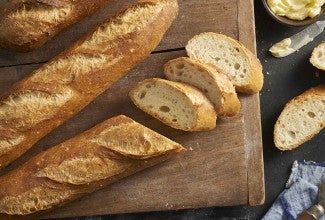Baking trials: Just how much does scoring impact bread?
For better loaves, score your bread the right way.
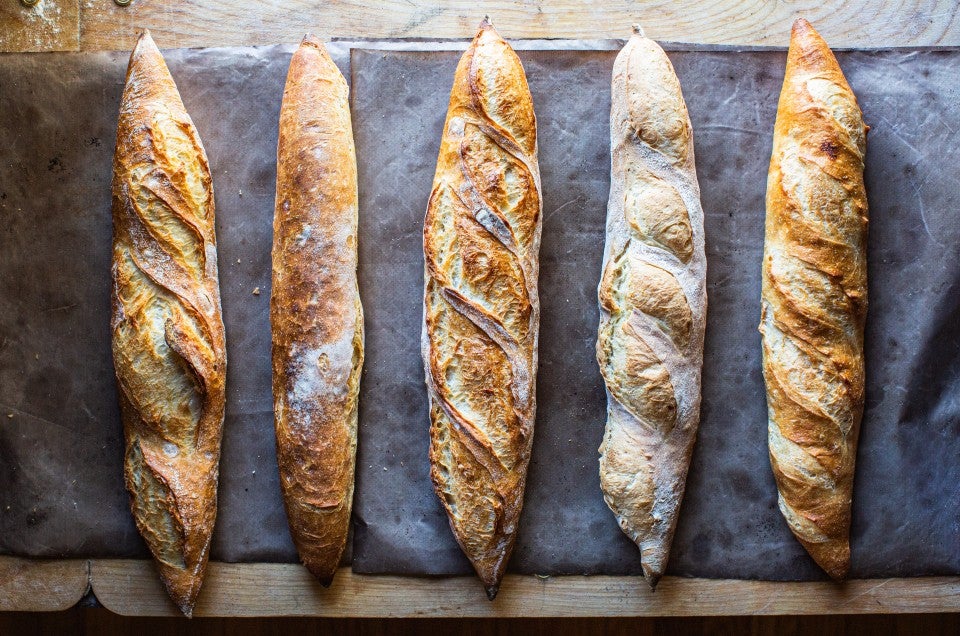

When most people hear “scoring,” they think three-pointers, touchdowns, or hat tricks. But bakers? For us, scoring means one thing: bread. From functional cuts that improve the volume and structure of our loaves to decorative choices meant to add beauty, scoring is one of the most impactful steps in bread baking. But is it as simple as a couple quick slashes and you’re done? Not quite. Let’s look at examples of what to do and what to avoid to help master this essential skill.
Scoring is the baker’s word for cutting the exterior of loaves prior to baking. With a razor blade (known as a “lame,” but pronounced “lahm”) or sometimes a pair of scissors, cuts are made that guide the loaf’s expansion in the oven.
During the initial phase of baking, loaf temperature rises, yeast activity increases, and moisture in the dough converts to steam. These factors cause the loaf to expand significantly in a process known as “oven spring.” Good oven spring leads to bread with open interiors and thin crusts. But, lacking a score — a weak spot on the loaf’s exterior that guides the opening process — oven spring is limited. For the best hearth bread possible, scoring is essential.
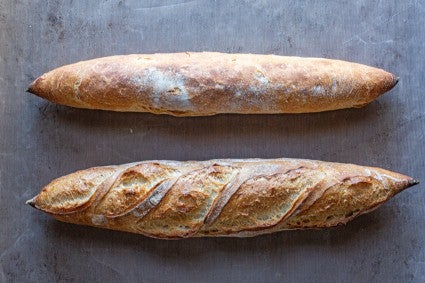
Let’s compare a scored and unscored loaf from the same batch of baguettes. Here, the upper image is a baguette I didn’t score and, on the bottom, a scored loaf. While the scored loaf expanded fully and achieved greater overall volume, the uncut loaf was clearly restricted — its interior is tight and dense. Lacking a place where it could open, there was no opportunity for further expansion after the crust set.
But loaf size isn’t the only reason to score your bread. While a loaf that expanded well in the oven is certainly pretty, the inside of the loaf is also significantly impacted by scoring.
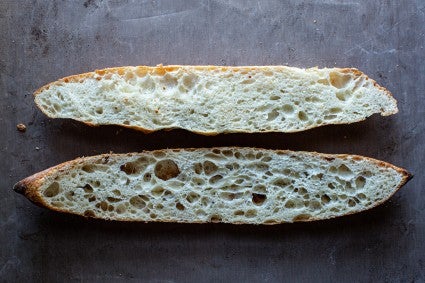
In the image above, the scored loaf on the bottom is open, well-expanded, and light while the other is dense in texture. For the best crumb, score your bread!
But you don't just need to score your bread — you need to score it well. Here are some other factors to consider.
When scoring, it’s important to use the right tool. While you technically can score bread using a kitchen knife, knives require more pressure to slice the dough than a lame because they have thicker (and typically duller) blades. The extra pressure required to make cuts with a knife compresses the loaf and results in jagged cuts that are deeper than necessary
In contrast, the sharper, thinner lame cuts with less pressure, entering only the thin surface of the dough with precision; this leaves the rest of the loaf untouched and ready for maximum oven spring. For best results, I like a lame with replaceable blades so I always know I have the sharpest tool possible.
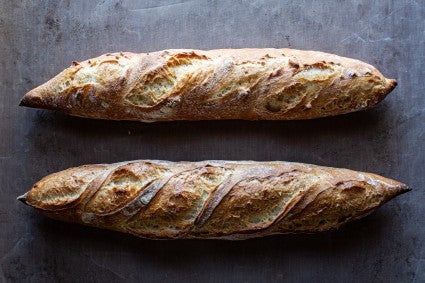
In the baguettes above, the lame-scored loaf on the bottom has a nice crisp score with a swooping form, while the knife-scored loaf is bumpy because the blade dragged and cut too deeply. (More on cut depth, below.) The result is a flatter, splayed loaf, with a jagged, uneven opening.
We also want to place the cuts where they matter most. Placement depends on the shape of the loaf: With boules (round loaves), you want the cut to be symmetrical, evenly releasing the loaf in all directions. For baguettes, it should be a series of five to seven symmetrical cuts, evenly distributed along the midline of the baguette and overlapping by roughly a third. For bâtards, one cut running lengthwise down the middle of the loaf is a great place to start.
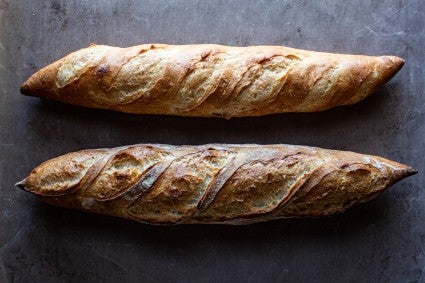
In the lower image, my cuts are well-placed, overlapping slightly along the midline of the dough to create a focused seam of weakness. By aligning the cuts, we guide the loaf to expand evenly, producing a beautiful and functional result.
In the upper image, my cuts are poorly placed. They don’t overlap enough, and their angle is more across the loaf (I call this error the “barbershop cut” as it reminds me of a barber’s pole), rather than landing along the midline. In this instance, the cuts don’t help the loaf expand, and the appearance isn’t that of a classic baguette. For more about the placement of cuts and additional options, here are some helpful tips.
Like cut placement, different doughs also require different cutting depths. We can simplify the options to two types of loaves with different requirements.
The first category is made up of loaves, like many of our sourdoughs, that are chilled after shaping and before baking. Because those loaves lose moisture in the refrigerator, they develop a thicker skin, and thus require a deeper cut — up to 1/2" or even 3/4" in some cases. If we don’t cut these chilled loaves deeply enough, we won’t fully release the loaf. (Our Pain de Campagne video has some examples.)
The second category is loaves that have their final proof at room temperature, such as baguettes or miche. Because their skin is thinner after proofing, they require a shallower cut, as small as 1/4". Our Classic Miche video is a great place to see a light touch in action.
Let’s look at examples of too shallow, too deep, and proper scores with a baguette proofed at room temperature.
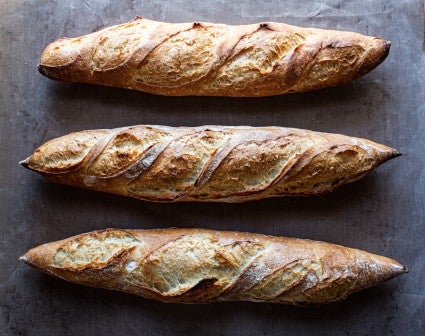
The bottom loaf wasn’t cut deeply enough — it’s etched, rather than scored. And the result is that I didn’t cut through the skin with every slash. While the loaf tried to spring as best as it could, with a deeper cut the scores would be more defined and the expansion more even.
In the top example, it’s the opposite problem. I purposefully cut too deeply, and you can see the deep cut didn’t leave the dough with much energy; I released it too fully. As a result, the loaf spread horizontally, splaying open rather than energetically rising upward.
And last, in the middle baguette, I found a balance between the two extremes, cutting through the skin but not far beyond that. The loaf opened with nice expansion and good definition.
Last, let’s talk about the role of steam as it relates to scoring. If we don’t steam, scoring will not have much effect. Even if you’ve scored your bread perfectly, you need moisture in the oven to allow the scores to open and the loaf to expand before the crust sets. Without steam, even well-scored loaves will fall short.
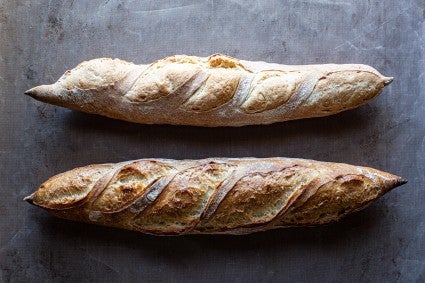
So, two baguettes. The top one is baked without steam and the other is a well-steamed loaf. Similar to the results of the scored and unscored loaves, you can see that volume, expansion, beauty, and crumb are compromised by the lack of steam. (For more information on steaming and the benefits, see our guide to baking bread with steam at home.)
For the best possible breads, you not only have to score, but you also have to score properly. In addition, to preserve those scores you need to add moisture to the oven while the bread bakes — it's the one-two combo that’s required for the best bread.
Still curious about scoring and how to improve? Here are some options:
Cover photo and food styling by Martin Philip.
